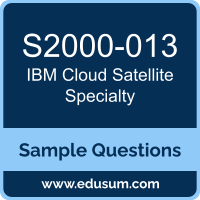01. What is required for IBM Cloud to monitor and return the health status of the host?
a) Install monitoring agent on the host
b) Assign hosts to the IBM Cloud Satellite location
c) Attach hosts to the IBM Cloud Satellite location
d) Enable log and monitoring service on the host
02. After setting up a location endpoint, the client can connect to the destination resource on an IBM Cloud Satellite location. How can access to the resource be restricted?
a) IAM (Identity and Access Management) policies
b) Security Groups
c) ACL (Access Control List)
d) A list of source IP ranges
03. Which two types of logs are captured from an IBM Cloud Satellite Location when enabling IBM Log Analysis for an IBM Cloud Satellite deployment?
a) Bare metal logs
b) Power supply logs
c) Virtual machine logs
d) Platform logs
e) Red Hat OpenShift on IBM Cloud cluster logs
04. Financial Institutions expect instant, customized reports but complex financial modeling creates latency. Which IBM Cloud Satellite capability can solve this business challenge?
a) Multiple high speed, Multi-Zone Regions (MZRs) ensure low-latency interconnected zones
b) Applications and workloads are deployed within segmented network zones alleviating latency
c) Data processing happens close to the data alleviating latency even when using predictive analytics
d) Core technology includes compute isolation for cloud native and VMware workloads mitigating latency concerns
05. Who is responsible for change management (such as operating system, container platform, and security updates) for the Satellite platform and the IBM Cloud Services deployed to locations?
a) Only IBM
b) Only the customer
c) Third-party partner
d) Both the customer and IBM
06. A client reports that hiring engineering talent in every location is challenging and costly. What is the IBM Cloud Satellite value that can solve this client challenge?
a) Adoption of continuous deployment and automation methods eliminates the need to manage services
b) Public cloud services automate the work of IT operations teams and eliminates the need to manage the services locally
c) Public cloud services automate parts of the software development life cycle thus reducing engineering costs
d) Public cloud services can be deployed in a consistent way to any location eliminating the need to manage the services locally
07. Which of the following is accurate when creating IBM Cloud Continuous Delivery pipelines that work with Red Hat OpenShift on IBM Cloud Satellite?
a) No toolchain templates are specifically provided for Red Hat OpenShift on IBM Cloud
b) IBM Cloud Continuous Delivery uses public workers by default in the toolchain configuration
c) Kubernetes toolchain templates can be used for Red Hat OpenShift on IBM Cloud Satellite
d) Red Hat OpenShift on IBM Cloud toolchain templates can be used for a cluster in a IBM Cloud Satellite location
08. Why do clients prefer managed OpenShift on IBM Cloud Satellite over OpenShift software?
a) Clients prefer to freeze Red Hat OpenShift to a specific version
b) Client controls and manages the master nodes
c) Clients prefer to maintain the open source lifecycle for Red Hat OpenShift
d) Enterprise isolation options including dedicated compute, bare metal servers, and private clusters
09. A customer owns their own infrastructure in an on-premises data center and uses multiple cloud providers. Why would IBM Cloud Satellite be chosen as a part of a client’s overall architecture?
a) Ability to run workloads in the physical location while securely using IBM Cloud services
b) Provides a form of infrastructure as a service (IaaS) to quickly create and deploy one or more virtual servers that are running either the AIX or IBM z/OS in public cloud
c) Contains streamlined and optimized ordering platform for VMware running on IBM Cloud
d) IBM Cloud Satellite is integrated with IBM Cloud Monitoring, DB2 Warehouse, and IBM Cloud Activity Tracker
10. What IBM Cloud Satellite Location information is stored by IBM to be used in the case of a disaster?
a) Sensitive Personal Information of the deployed hosts
b) Encryption keys deployed in the systems using IBM Cloud Satellite
c) Certificate Authority used for the primary web servers to access the system
d) IBM Cloud Satellite control plane and cluster metadata
 The purpose of this Sample Question Set is to provide you with information about the IBM Cloud Satellite v1 Specialty exam. These sample questions will make you very familiar with both the type and the difficulty level of the questions on the S2000-013 certification test. To get familiar with real exam environment, we suggest you try our Sample IBM Cloud Satellite Specialty Certification Practice Exam. This sample practice exam gives you the feeling of reality and is a clue to the questions asked in the actual IBM Cloud for Satellite v1 Specialty certification exam.
The purpose of this Sample Question Set is to provide you with information about the IBM Cloud Satellite v1 Specialty exam. These sample questions will make you very familiar with both the type and the difficulty level of the questions on the S2000-013 certification test. To get familiar with real exam environment, we suggest you try our Sample IBM Cloud Satellite Specialty Certification Practice Exam. This sample practice exam gives you the feeling of reality and is a clue to the questions asked in the actual IBM Cloud for Satellite v1 Specialty certification exam.